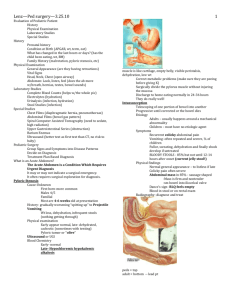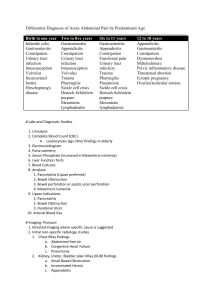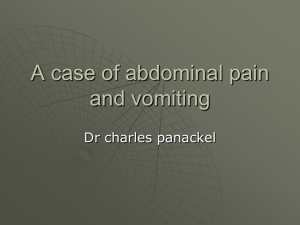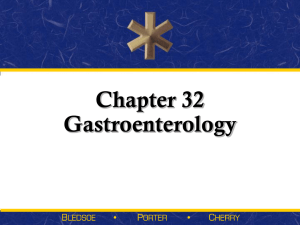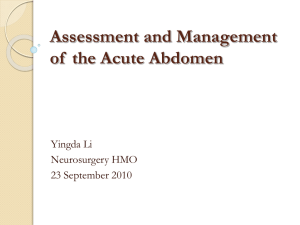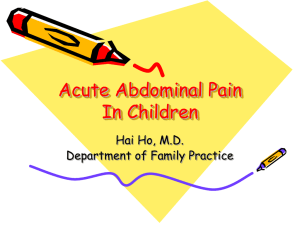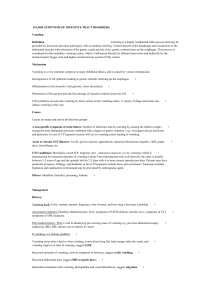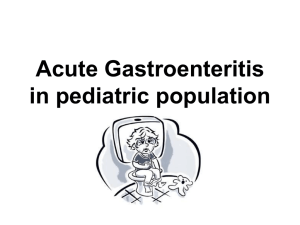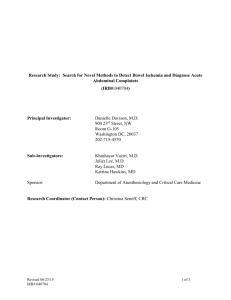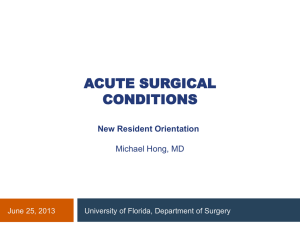File
advertisement
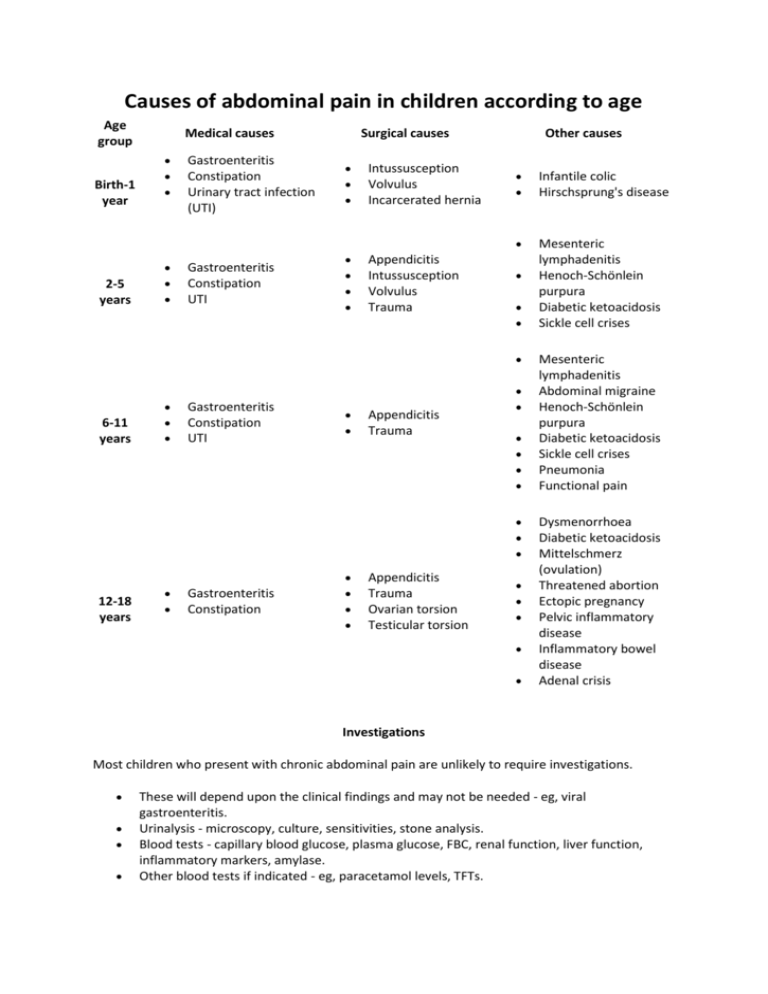
Causes of abdominal pain in children according to age Age group Birth-1 year 2-5 years Medical causes Surgical causes Gastroenteritis Constipation Urinary tract infection (UTI) Intussusception Volvulus Incarcerated hernia Gastroenteritis Constipation UTI Appendicitis Intussusception Volvulus Trauma Other causes Infantile colic Hirschsprung's disease Mesenteric lymphadenitis Henoch-Schönlein purpura Diabetic ketoacidosis Sickle cell crises 6-11 years Gastroenteritis Constipation UTI Appendicitis Trauma 12-18 years Gastroenteritis Constipation Appendicitis Trauma Ovarian torsion Testicular torsion Mesenteric lymphadenitis Abdominal migraine Henoch-Schönlein purpura Diabetic ketoacidosis Sickle cell crises Pneumonia Functional pain Dysmenorrhoea Diabetic ketoacidosis Mittelschmerz (ovulation) Threatened abortion Ectopic pregnancy Pelvic inflammatory disease Inflammatory bowel disease Adenal crisis Investigations Most children who present with chronic abdominal pain are unlikely to require investigations. These will depend upon the clinical findings and may not be needed - eg, viral gastroenteritis. Urinalysis - microscopy, culture, sensitivities, stone analysis. Blood tests - capillary blood glucose, plasma glucose, FBC, renal function, liver function, inflammatory markers, amylase. Other blood tests if indicated - eg, paracetamol levels, TFTs. Stool samples if there is diarrhoea - microscopy, culture and sensitivity; ova, cysts and parasites. Abdominal imaging - abdominal X-ray (looking for obstruction), CXR (looking for pneumonia and air under the diaphragm), ultrasound scan of the abdomen and testes. CT scan may also be appropriate. More specialist investigations - eg, barium enema - will depend upon preliminary findings. Differential diagnosis for rectal bleeding The likely causes in children vary with age. Anal fissure: o Occurs in neonates and infants but also in older children. o Bright blood and pain are features of this condition. o Fissure is visible on examination and no further investigation is required. o Stool softeners may be needed if the child is constipated. Volvulus: o Can occur in neonates and infants. o In neonates, it is heralded by sudden onset of melaena and bilious vomiting. o In infants, volvulus can also occur and presenting features include vomiting and abdominal distension. o Rectal bleeding occurs relatively late with development of gangrenous bowel. o Classic plain X-ray finding in midgut volvulus is the double bubble sign. Ultrasound can also be used. Intussusception: o Occurs most often between 6 and 18 months. o Pain (paroxysms about every 10-20 minutes of colicky abdominal pain), distension, vomiting and a sausage-shaped mass are characteristic, as is the passage of blood and mucus in the form of redcurrant jelly stool. o Abdominal X-ray - may show dilated gas-filled proximal bowel, paucity of gas distally, multiple fluid levels (but may be normal in the early stages). o Ultrasound - may show doughnut or target sign, pseudokidney/sandwich appearance. It is a very effective modality and many consider it the investigation of choice. o Bowel enema - barium has been the gold standard (crescent sign, filling defect) but air and water-soluble double-contrast now available; each has pros and cons choice is left to th individual radiologist. Milk protein allergy: e o Can cause occult or overt rectal bleeding. o It is also associated with diarrhoea, weight loss, vomiting and general irritability. o Diagnosis is made clinically, as symptoms resolve when the offending milk product is withdrawn. Polyps: o Generally, these cause painless recurrent bleeding.[1] o In infants and up to teenage years they are most often juvenile polyps which autoamputate and usually require no treatment. o Other polyposis syndromes are diagnosed at colonoscopy.[2] Syndromes include juvenile polyps and polyposis, Peutz-Jeghers polyposis and familial adenomatous polyposis. Meckel's diverticulitis: o This is more common in children aged younger than 2 years, and in males. o The patient usually reports bright red blood in the stools. The amount may vary from minimal recurrent episodes to a large shock-producing haemorrhage. Meckel's diverticulum should always be excluded in a child presenting with massive painless rectal bleeding. o Can also cause melaena at about age 10 years. o When children present with haemorrhage and a suspected Meckel's diverticulum, technetium 99m pertechnetate scintigraphy is the modality of choice.[3] o Laparoscopy may be used for diagnosis and management.[4] Inflammatory bowel disease (IBD):[5] o This starts to become more common over the age of 2 years. o Bleeding occurs less often with Crohn's disease than with ulcerative colitis, but both can cause bloody diarrhoea. o Crohn's disease, ileocolonoscopy and biopsies from the terminal ileum as well as each affected colonic segment, to look for microscopic evidence of Crohn's disease, are first-line procedures to establish the diagnosis. o Rectal bleeding usually occurs in children known to have IBD rather than as a presenting feature of the IBD. Infectious diarrhoea: o Includes that caused by Clostridium difficile and causes bleeding associated with profuse diarrhoea. o Gastroenteritis in many varieties (more commonly Campylobacter spp.). Differential Diagnosis of Abdominal Mass in Children Neonates Renal Hydronephrosis* Multidysplastic kidney* Mesoblastic nephroma* Renal vein thrombosis† Polycystic kidney disease† Wilms’ tumor† Rhabdoid tumor† Pelvic Ovarian cyst Hydrocolpos Hydrometrocolpos Gastrointestinal duplication Infants and children Retroperitoneal Neuroblastoma Wilms’ tumor Lymphoma Liver Hepatoblastoma* Embryonal sarcoma† Gastrointestinal Duplication Meckel’s diverticulum Fecal mass Pelvic Ovarian cysts Teratomas Mesenteric lymphadenitis This is associated with adenoviral infection. It presents similarly to appendicitis but there is no peritonism. The abdominal pain tends to be more diffuse. There may also be generalised lymphadenopathy. Infantile colic Synonym: gripe Occurs in babies in the first few months after the birth month. Babies scream, draw up their knees and experience severe pain. Episodes can last up to three hours and occur often in a week. Changes in feed type and routine may help. Over-the-counter medicines - eg, simeticone - may help, but have not been proven to be of benefit.[5] Causes of vomiting in children Gastroenteritis; (an infection of the gut) is a common cause of vomiting in children, and usually goes away after a few days. Food allergy; can also cause vomiting in children. Watch out for certain foods that may bring on the vomiting, and see if your child is better after avoiding this food. Labyrinthitis; is an inner ear infection that causes dizziness and a feeling of spinning as well as nausea and vomiting. Your GP will be able to prescribe medication to relieve your child's symptoms while their immune system fights off the infection, which may take a few weeks. Appendicitis’ can cause vomiting in children, as well as extreme pain in the tummy. It is a medical emergency and means your child's appendix will need to be removed. You should dial 999 for an ambulance if you think your child has appendicitis. Click on the above link to find out more about it. Poison Causes of vomiting in babies These include: Swallowing lots of air during feeding. Gastroenteritis (an infection of the gut). A food allergy or milk intolerance. Gastro-oesophageal reflux, which is when stomach acid escapes back up the gullet. Too big a hole in the bottle teat, causing your baby to drink too much milk. Accidentally swallowing a drug or poison. A birth condition where the passage from the stomach to the bowel has narrowed and food cannot pass through easily, causing projectile vomiting. This condition is called congenital pyloric stenosis. A blockage, such as a hernia, in your baby's bowel. They will vomit frequently and cry as if in great pain. Bilioud vomiting in newborn = obstruction = Duodenal atresia, midgut malrotation and volvulus, jejunoileal atresia, meconium ileus and necrotizing enterocolitis are the most common causes of neonatal intestinal obstruction. PYLORIC STENOSIS • cause- unknown • usually first born baby boy usually presenting at the 2nd to 8th week of life • strong familial pattern Clinical Features • vomiting - frequent, forceful, non-bilious with/without haematemesis. The child is keen to feed but unable to keep the feed down • failure to thrive • dehydration • constipation • seizures Physical Examination • dehydrated • a test feed can be given with the child in the mother’s left arm and visible gastric peristalsis (left to right) observed for. The doctor’s left hand then palpates beneath the liver feeling for a palpable olive sized pyloric tumour against the vertebra. Investigation • investigation to confirm diagnosis usually unnecessary - abdominal ultrasound - barium meal • pre-operative assessment is very important - metabolic alkalosis is the first abnormality - hypochloraemia < 100 mmol/l - hyponatraemia < 130 mmol/l - hypokalaemia < 3.5 mmol/l - hypocalcaemia <2.0 mmol/l - jaundice - hypoglycemia - paradoxical aciduria - a late sign Therapy • rehydration - low (rapid will cause cerebral oedema) except if perfusion is poorPAEDIATRIC SURGERY • fluid - ½ saline + 10%D/W (+ 5-10 mmol KCL/kg/day) at 150 ml/kg/day + % dehydration - replace nasogastric losses with normal saline - Do Not give Hartmann’s solution (the lactate will be converted to bicarbonate) • insert a nasogastric tube – 4 hourly aspiration with free flow • pyloromyotomy after the electrolytes have been corrected
